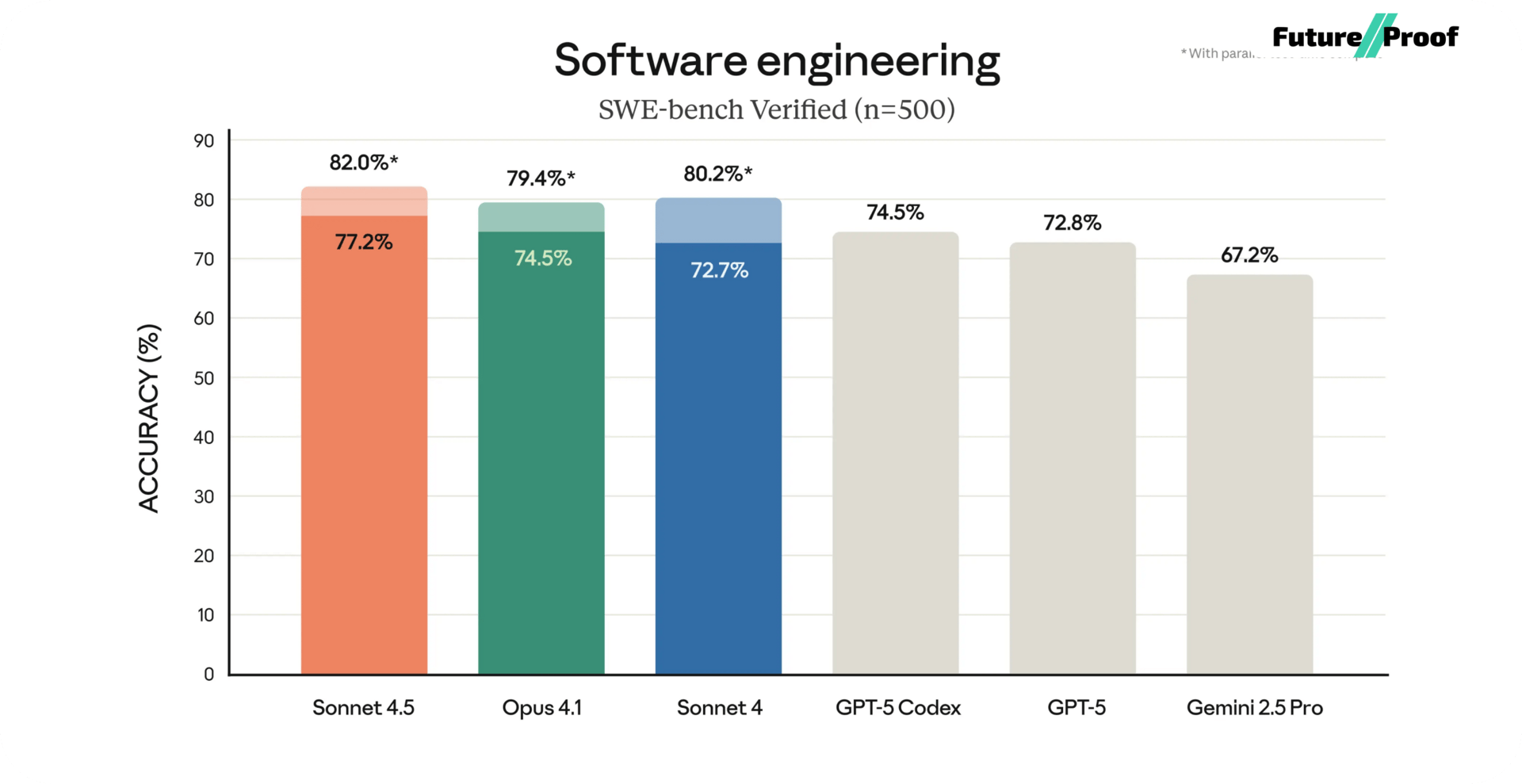- Future//Proof
- Posts
- 📊 JPMorgan Builds World’s First Fully AI-Powered Megabank
📊 JPMorgan Builds World’s First Fully AI-Powered Megabank
Discover how JPMorgan’s AI shift could change your career in an instant👇
Welcome to the Future//Proof 🚀
👋 Hello , the AI Enthusiast.
In this week’s edition, we brought AI updates backed by high-quality research and data to give you deeper insights. You'll find the Top AI Breakthrough of the Week, a featured AI tool with a mini-tutorial, learning resources to help you master these tools, the top 3 AI news stories, and more.
Our goal is to help you improve your knowledge and stay ahead in the rapidly evolving AI landscape. You can submit your questions, queries, thoughts, opinions or anything regarding AI as a reply to this email and we'll feature and address them in our next newsletter.
🚀 Now Let’s dive in and explore the new AI Insights together!
⌛ Read Time: 5m:34s

An in-depth look at a major AI development, its industry impact, how it could affect your career, and a bold future prediction.

Anthropic pushes Claude Sonnet 4.5 as the strongest coding model yet
Anthropic has launched Claude Sonnet 4.5, raising the bar in coding and autonomous agent performance. The model scored 77.2% on SWE-bench Verified (82% under high compute) and delivered a 19-point leap on OSWorld-Verified computer-use tasks (61.4% vs. Sonnet 4’s 42.2%). It sustained 30+ hours of uninterrupted coding focus, signaling major progress in long-horizon autonomy. Key upgrades include Claude Code checkpoints, a VS Code extension, and an Agent SDK exposing Anthropic’s internal scaffolding for memory, permissions, and multi-agent coordination. Pricing remains unchanged at $3 input / $15 output per million tokens. Sonnet 4.5 is available via Anthropic API, AWS Bedrock, Google Vertex AI, and GitHub Copilot, positioning it as the most accessible, production-ready coding and agent model at scale.
Potential Impact
Sonnet 4.5 directly boosts enterprise software engineering, RPA-style automation, and developer productivity. Companies can now deploy agents that manage end-to-end coding cycles, navigate spreadsheets and web apps, and complete browser flows with fewer interventions. For developers, the combination of checkpoints, VS Code integration, and long-memory scaffolding reduces rework and unlocks complex builds that span days instead of minutes. This isn’t just faster code; it’s a shift toward AI maintaining full software projects and enterprise processes with minimal human oversight.
Implications for People/Careers
Entry-level coding jobs face accelerating risk as Sonnet 4.5 proves reliable on standard engineering benchmarks. Mid-level engineers must adapt from writing code to designing, supervising, and integrating AI-driven pipelines. Senior engineers gain leverage if they master orchestration, debugging AI outputs, and designing scalable agent workflows. The winners will be those who pivot into AI-first engineering roles, while those stuck in traditional coding cycles will find their work increasingly automated. The shift is no longer theoretical models like Sonnet 4.5 are proving usable for multi-day, enterprise-grade projects.
Our Future//Take
Claude Sonnet 4.5 signals the industrialization of AI agents—from demos to long-duration, high-reliability systems. Within 12–18 months, expect Fortune 500 firms to restructure workflows around such agents, cutting costs while scaling delivery speed. For you, the immediate move is clear: embed AI into your software lifecycle now. Learn how to manage agent scaffolding, integrate memory across workflows, and oversee multi-day automated builds. Startups will spring up around orchestration, monitoring, and agent governance. Education and training systems will need urgent upgrades to prepare talent for this new baseline. This release marks a pivot point: coding is no longer the ceiling of AI; it’s the foundation. Master AI for FREE 🎁

Quick summaries of this week's top AI news, their relevance to your career, and our expert opinions.
JP Morgan Chase, the world’s largest bank by market cap, is rolling out its in-house LLM Suite, updated every eight weeks with fresh data from across its businesses. Built on models from OpenAI and Anthropic, the suite already creates investment decks in 30 seconds work that took junior bankers hours. The roadmap now moves into agentic AI, where autonomous systems handle multi-step tasks inside operations, client service, and employee workflows. The goal: every employee has an AI agent, every back-end process is automated, and every client touchpoint gets an AI concierge. This is not an experiment; it’s a fundamental rewiring of a trillion-dollar bank. If JPMorgan succeeds, it sets a precedent for regulated industries, forcing competitors to adopt similar architectures or risk irrelevance.
Why It Matters to You
If you build, sell, or compete in financial services, your benchmark just reset. Manual processes won’t cut it when the largest bank shows clients AI-curated experiences and staff AI copilots. For creators and founders outside finance, the signal is broader: workflows that once took teams can collapse into seconds. The market will now expect speed, personalization, and precision by default. If you don’t integrate AI agents into your stack, your competitors will and their cost structures and client experience will eclipse yours.
Our Take
This is Wall Street’s iPhone moment for AI. JP Morgan isn’t dabbling; it’s institutionalizing agentic systems at scale. The next 24 months will see copycat adoption across banking, consulting, and insurance. Expect regulators to tighten oversight, but the first-mover advantage is real. If you run a company, start piloting agentic AI now automate repetitive cycles, rewire client touch-points, and build governance into your stack. The era of AI-assisted employees is already here. The winners will be those who design organizations around agents, not humans patching over them.
Sora 2 is OpenAI’s new video and audio generation model, advancing beyond simple prompts to physics-consistent world simulation. Unlike earlier models that bent reality, Sora 2 obeys dynamics basketballs bounce off backboards instead of teleporting. It handles multi-shot instructions, cinematic persistence, and generates synchronized dialogue, sound effects, and ambient audio. The launch includes the Sora iOS app, where users can generate, remix, and star in each other’s videos via “cameos” record once and the system recreates your likeness and voice across AI worlds. OpenAI emphasizes responsible rollout with natural-language-tuned feeds, teen safeguards, and limits to promote creation over passive consumption. This is not just entertainment: it’s the foundation for AI systems that simulate the real world, making video as programmable as text.
Why It Matters to You
Video is no longer a costly production asset; it’s a programmable medium. Sora 2 collapses filming, editing, acting, and sound design into a single interface. For entrepreneurs, it lowers entry barriers for storytelling, marketing, and education. For creators, it means your audience expects faster, higher-quality, and more personalized content. For strategists, it signals a world where user likeness and voices become portable digital assets; opening markets in entertainment, training, advertising, and even virtual commerce. If you aren’t planning how AI-native video reshapes your workflows, your competitors are.
Our Take
Sora 2 is the GPT-3.5 moment for video; good enough to change behavior, not just impress demos. The real unlock is controllability and realism, which pushes AI video from toy to tool. Expect two waves: social adoption via cameos, then enterprise adoption in media, gaming, and training. The competitive edge will come from building businesses and communities that integrate “programmable reality” into daily interaction. Start experimenting now treat your brand, team, and product as characters in this new medium. Those who master AI-native video storytelling will dominate attention, education, and influence in the coming cycle. 👉 Do Not Delay Anymore - Master AI Before Its Too Late.
Accenture has laid off 11,000 employees as part of an AI-driven restructuring, shrinking its headcount from 791,000 to 779,000 in three months. CEO Julie Sweet called up-skilling the number one strategy, but admitted some roles cannot be re-skilled at the speed or depth AI demands. The company has already generated $2.6 billion in AI consulting revenue in six months and is reinvesting savings an estimated $865 million severance cost into training and hiring AI-ready talent. CFO Angie Park confirmed this also includes divesting two acquisitions to accelerate “rapid talent rotation.” The strategy follows a trend seen at Microsoft and Meta: layoffs paired with aggressive AI hiring. Accenture’s position is clear AI is “expansionary, not deflationary,” and the company wants to be the global partner of choice for AI transformation.
Why It Matters to You
If Accenture is cutting tens of thousands yet calling AI “expansionary,” you can’t ignore the signal. This isn’t cost-cutting; it’s workforce re-architecture. The demand for AI-literate professionals will rise fast, while low-skill, manual consulting work evaporates. If you’re a founder, start re-skilling your team before clients ask why you’re slower than Accenture. If you’re an ambitious professional, build AI leverage into your toolkit; automation, prompt engineering, data fluency because the market will reward only those who can scale knowledge work through machines.
Our Take
Accenture is showing the blueprint: cut roles AI can absorb, reinvest in AI-native skills, reposition for higher-margin work. Expect every consulting giant to follow this playbook by 2026. For you, this is a forcing function either you integrate AI at scale or you’re priced out of competition. Start by identifying repeatable tasks in your workflows and testing agentic systems now. Don’t wait for industry standards; by then, Accenture will own the reference model and you’ll be catching up. The winners in this cycle will be those who reorganize around AI before it becomes survival, not strategy. ⚡AI Mastery for FREE (Sign up Now).

Discover a comprehensive guide to an AI tool, exploring its features, practical use cases, and learning resources to help you master it.

🗣️ Sora 2
Sora 2 is OpenAI’s next-generation text-to-video model, designed to generate cinematic, ultra-realistic videos directly from written prompts. It builds on Sora’s foundation but expands scale, control, and accessibility - positioning it as a creative tool for film, marketing, design, and education.
⭐ Top Features
Ultra-Realistic Generation: Produces photorealistic 1080p and 4K videos with natural motion, lighting, and scene depth.
Extended Duration: Create videos up to 10 minutes long, with continuous narrative consistency.
Fine-Grained Controls: Adjust camera angles, transitions, zooms, and subject framing using cinematic prompt commands.
Multi-Character Dynamics: Generate realistic interactions between people, animals, and environments within the same scene.
Physics-Aware Worlds: Objects move with natural weight, reflections, and cause-effect realism for believable results.
Creator Integration: Direct export to editing pipelines; optimized for professional workflows in film, advertising, and education.
OpenAI Studio Access: Available through OpenAI Studio, with APIs enabling developers to embed video creation inside apps.

A curated list of noteworthy AI tools and their key details to help you stay ahead in your field.

FlowAI enables teams to create and deploy AI agents without writing code. It supports multi-step automation, third-party integrations, and live dashboards, letting anyone design workflows that scale across business operations. With FlowAI, non-technical teams can prototype, launch, and monitor agents in real time.

Kilocode is an AI-first coding environment that helps developers design, test, and deploy apps faster. It combines code generation, debugging, and collaboration tools into a single workspace, making it easy to transform natural language into production-ready software. Built for engineers and startups, Kilocode accelerates the entire development lifecycle.

Dreamflow is a creative AI platform that lets artists and teams generate visuals, music, and interactive media. It blends generative models with collaborative project tools, allowing creators to co-design immersive experiences with AI. From concept art to audio landscapes, Dreamflow streamlines ideation and production.

Jobright is an AI-powered career platform that curates real-time job opportunities, tailors applications, and optimizes resumes. It integrates live market data with personalized recommendations, helping professionals target the right roles quickly. For job seekers, Jobright automates tedious search and positioning tasks, freeing time to focus on interviews and networking.

A quick poll to help you recollect and engage with key points from the newsletter.
How does JP Morgan’s agentic AI impact client service? |

Share your feedback on today's edition to help us improve and better meet your needs.
How was Today’s Edition? |
Share our Newsletter ⏩
Enjoying our insights on the latest AI breakthroughs? Don’t keep it to yourself! Share this newsletter with friends and colleagues who are passionate about technology and AI innovation.
If you haven’t subscribed yet, make sure to subscribe here to stay updated with cutting-edge AI news, tools, and tutorials delivered straight to your inbox!
Ask Us Anything AI ❓
Got questions? We've got answers!
Submit your questions, queries, thoughts, opinions or anything regarding AI and we'll feature and address them in our next newsletter. Your curiosity drives our content!
👇 Reply to this email with your questions, and we'll answer them in our next edition!👇